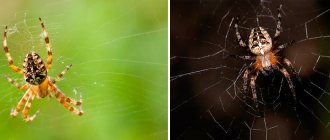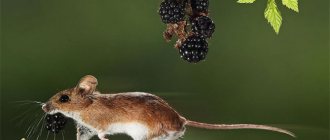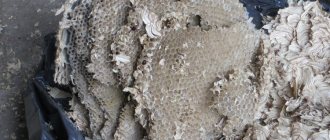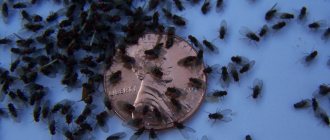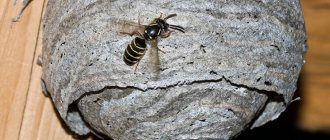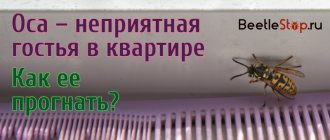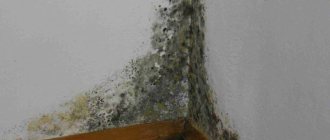A wasp sting makes a strong impression and is remembered, if not forever, then for a very long time. Let's consider the advantages and disadvantages of known means used to protect against unwanted insects in a summer cottage.
Many gardeners love and consider wasps to be beneficial insects, as they help in the fight against the larvae of many pests. However, these statements are only good until the first bite. The poison that the wasp injects under the skin during a bite often causes severe allergic reactions.
The most reliable way to get rid of wasps is to contact specialists who have all the necessary skills, experience, as well as equipment that can protect against an attack by an aggressive wasp swarm. If you do not have the opportunity to turn to specialists, we will give some useful tips that will help you poison them yourself.
Don't underestimate your enemy
When declaring war on wasps, you should first take care of your own safety . Their bites are really dangerous for humans, so do not forget that after a bite the wasp does not lose its sting, so it can attack many times. Those who have experience dealing with aggressive individuals are advised to wear a large amount of loose clothing. But most of all, you will protect yourself if you wear protective beekeeper overalls. In addition to a protective suit, take a good flashlight, because wasps most often build their nests in dark attics or unlit corners. You will need a constant light source, so it is better to mount the flashlight on a stationary vertical surface.
If the subject of the fight is ground wasps, how to get rid of it: keep buckets of earth ready, with which, if necessary, you can fill the nest and, if danger arises, leave the battlefield, in order to avoid being chased by a train consisting of a swarm of wasps.
Prepare an allergy medicine and ice , which will come to your aid in case of bites. A tourniquet, which will be required to be applied above the bite site to suck out the wasp venom, will also not hurt. This is done in cases of severe allergies to avoid anaphylactic shock.
Get some neighbors to help you. You will need a companion to carry the weapon, as well as a person who can provide first aid in case of a bite. For example, if a severe allergic reaction occurs in the form of confusion, dizziness, a sharp decrease in blood pressure, or even suffocation. Think carefully about all your escape routes in case of an unsuccessful battle.
Peppermint
Wasps really don't like the smell of peppermint. Dilute 30 drops of its essential oil in half a liter of water and spray the resulting solution onto the hive. For better adhesion, you can add a little shavings of laundry soap.
Peppermint is also good for preventing the formation of wasp nests. Treat the balcony and windows with mint solution, and you can also grow the plants themselves on the site.
Anti-wasp drugs
Most modern drugs are capable of destroying an entire hornet's nest. However, there are several nuances:
- do not forget that poisoned baits can also infect beneficial insects - pollinators, as well as domestic animals;
- Another difficulty is that in order to completely destroy the nest, it is necessary to kill not only the adults, but also the larvae and the queen. This can be quite difficult, because wasps often build their homes in places inaccessible to people;
- The poison used in baits is quite toxic and odorless. It comes in several versions: powder, gel, glue. A means for killing wasps directly in the nest is sold in the form of a spray or concentrated liquid. Such means are suitable for the destruction of adults and their larvae.
Benefits of a wasp swarm
Wasps, like all insects, are an integral part of our ecosystem, inhabitants of green flora and fauna, and undoubtedly benefit plants. In the struggle for a place in the sun, wasps destroy smaller insects and feed on their larvae. A swarm of aspen can destroy about a hundred insect pests in just one day, which is very significant on the scale of a garden plot. To feed their larvae, adults carry various caterpillars, aphids, scale insects, earth beetle larvae, including mole crickets, into their nests. Small flies, Colorado potato beetle larvae, and moth caterpillars are excellent protein food for the younger generation of wasps. Feeding the larvae with insect pests leads to a natural decrease in the number of pests on the site, and this fact will not only please every gardener, but will become a powerful argument in favor of wasps.
Wasps take an active part in pollinating flowering plants and vegetable crops, which also indicates the benefits of insects in the garden.
Effective poison for wasps
- A fairly popular insecticide for killing wasps is boric acid. It is characterized by complete absence of odor, so it is suitable for use at home.
- The well-known dichlorvos has changed somewhat recently. The drug presented today has changed somewhat; now it does not kill all living things at once, thanks to its toxic aroma. But it is still effective against many types of insects.
- Karbofos has an extremely unpleasant odor and low cost. Ideal for irrigating a wasp's home, however, several procedures are required to completely destroy the insects.
- Delta zone - the product has a slight odor that does not repel wasps, so it can be used as part of bait.
- Get is a modern remedy that does not have a pungent odor. Ideal as part of bait for destroying wasp nests. The downside is its detrimental effect on all insects.
- OtOc" - the product contains sugar, poison, and flavorings that attract wasps. Sold as a ready-made bait, the manufacturer guarantees the safety of this product for bees.
Important! If you are bitten by a wasp while treating the nest with a product, do not kill it, so as not to provoke an aggressive attack by an entire swarm.
The existing wasp control agent in the form of glue operates on a single principle: the surface of the cardboard is covered with the product and bait is laid out. The downside is that most beneficial insects also bite on the bait, and the product is not able to cope with a whole swarm of wasps at once.
Getting rid of a nest with wasps under the roof of a house or barn
If it is difficult to get to the wasp hole, for example, it is located under the roof of the roof (free space under slate, tiles, etc.), first get rid of the wasps themselves. When there is unobstructed access to the entrance to the hive, insecticidal dust, for example, Sevin 5 Garden Dust, is scattered near it in the evening. The insects will collect the poison, bring it into the home, and infect other individuals. The procedure is repeated several times (daily) until all the inhabitants of the hive die.
Instead of powder, various poisons are used. Bulk or liquid preparations (OTOS, Adamant, Inta-Vir, Sherpa, Get, etc.) are mixed with bait: fermented jam, kvass, beer, spoiled fruit, melon pieces, watermelon skins, meat or fish. The treat is placed in a plastic bottle or other container, placed and hung near the roof, as well as where insects fly most often. The wasps do not die immediately; they manage to transfer food particles to the nest, thus infecting others.
Attention! For control, drugs without a strong odor are selected, otherwise the bait will scare them away. One of the best and inexpensive is boric acid (take half a teaspoon of powder per 100 ml of sweet syrup).
To prevent wasps from drowning in the bait, several long sticks (at an angle) are attached to the walls of the containers, which will serve as a kind of ladder. The poisonous treat is changed every 2–3 days; all insects will die only after 1–2 weeks.
To enhance the effect, traps are also hung around the perimeter of the roof; if they fall into them, the wasps will no longer be able to crawl out or fly out:
- Cut off the top part of the plastic bottle and turn it over so that the neck is facing down. Sweet syrup is poured inside (up to half the container);
- Alt-type glue is applied to a sheet of cardboard or plywood, then the surface is smeared with jam or honey, wanting to feast on the insects, they will stick to the surface.
Hardware stores offer a wide range of ready-made traps of various types. You can lure wasps out of the nest using a powerful vacuum cleaner; in this case, a tube with a wide nozzle must be placed directly at the entrance to the hive; this method is not always appropriate; in the process, the tube often becomes clogged with particles of the “structure.” They make their way to the nest only after even single individuals stop flying near the roof of a house or barn. The ceiling, if possible, is dismantled, the remains of the hive are removed, and they are burned. Cleaned surfaces are treated with a strong soap solution, and the area is then looked after.
Folk remedies
- The safest folk remedy for fighting wasps is a trap. They are sold in stores or prepared independently. In order to complete this trap, you will need an empty plastic bottle. A third of the bottle is cut off from the top and placed neck down in the cut-off part. The bottom is filled with something sweet, or better yet, fermented jam, beer, spoiled apples. However, experienced summer residents fear that these products, in addition to wasps, may also attract bees. To complete the production of the bait, you should add a poison to it that does not have a pungent odor for insects.
- This is a rather dangerous method, so you should not use it without special clothing. Take the insecticide, pour it into a strong plastic bag and firmly put it on the nest. Glue the edges to the surface on which the nest is built. The package should be removed after a few days, first by knocking next to it. After the nest is removed, the area where it was located should be treated with an insecticide.
Fighting methods: rules, features and characteristics
If, nevertheless, wasps on the site annoy the owner with their buzzing, the number of spoiled fruits, the danger of being bitten, and a decision has been made to destroy the nests 100%, then it is necessary to decide on a method of control.
Depending on the number of individuals, harm and fear, as well as the preferences of the owner of the site, methods are conventionally divided into humane and harsh. If in the first case, the owner tries to “relocate” the wasp’s nest to another place, away from the garden, then in the second case, the wasp’s nest is completely exterminated along with its inhabitants.
The principle of a humane method of struggle - TOP 3 proven methods
It is not difficult to show humanism towards insects that have not caused harm.
- Method 1. Cover the wasp's nest with a thick plastic bag or sack, tie it down as far as possible. Using a sharp knife, scrape the “wasp house” from the nesting site and, having moved it to a sufficiently far distance from the site, simply throw it away, first untying the bag. It is possible that wasps moved in this way will not find their way to their previous nesting site, which must be treated with a strong-smelling solution, for example, machine oil or diesel fuel.
- Method 2. Smoke out from the nesting site. Wasps are relatives of bees. As is known, beekeepers, before opening the hive, always fumigate it with smoke to give the bees a lethargic state and prevent stings. If you treat wasps humanely, you can build a fumigator and place it near the nest. If you constantly maintain the constructed fumigator in working condition, in other words, so that the smoke constantly envelops the nest, perhaps this will serve as a necessity for insects to change their nesting place and the wasps will leave your area forever.
- Method 3. Be patient, follow safety precautions and simply try not to notice. Perhaps the hardest thing for a gardener is to be patient and wait for winter to come. There are almost no live wasps in the nests at this time and there is no need to destroy them. With the onset of frost, empty wasp houses are scraped off from the nesting site and thrown away from the site. The nesting site must be thoroughly treated.
Perhaps, humane methods of dealing with wasps end here. When the owner of the site was repeatedly subjected to painful bites, which led to loss of ability to work and even hospitalization, this is not at all humane. Then, to exterminate wasp nests, they begin to use more severe methods.
“Hard” methods of exterminating wasps: TOP 10 proven methods
- Plastic bag or sack will become the basis for the fight. If the humane method of control suggested moving the contents of the bag away from the garden and releasing the wasps from it, then the radical method of control suggests sending the bag into a fire, dipping it in a barrel of water or in a pan of boiling water. Treat the nesting site with kerosene, machine oil or diesel fuel. An insecticide solution is also used for these purposes, with which the entire accessible surface is moistened.
- Spraying the nest with kerosene. Particles of liquid substance easily penetrate into all openings. Fill the wasp's nest with pure kerosene or another solution of petroleum products. It is believed that if some individuals survive after such a “shower,” they will leave this nest forever, which can be removed and burned if no longer needed.
- Insecticides . This is an expensive method of controlling wasps using drugs to combat, for example, the Colorado potato beetle. If you spend one time, you can exterminate the entire family. Only, perhaps, the solution for use should be made more concentrated than indicated on the package and fill the hanging nest or hole in the ground with it as much as possible. Remove the dead nest and burn it, and treat the area.
- Dichlorvos . A method that has been tested over the years and has proven itself, an insecticidal agent, can completely cope with the task. The wasp settlement is generously sprayed with a spray from a spray can. When the wasps simply begin to fall under the influence of the drug, it is necessary to cover the nest with polyethylene or a large container to prevent the flow of fresh air and spray dichlorvos inside again. Afterwards, wrap the bag as tightly as possible and leave it for a couple of hours. If the wasps turn out to be tenacious and a buzzing sound is heard through the polyethylene or bucket, spraying is repeated again and again. Afterwards, the “dead” nest is scraped from its place and the entire accessible surface is treated with an insecticide solution. When recommending the use of dichlorvos to kill wasps, it should be noted that a drug that has a strong pungent odor will have a positive effect. Know-how of the chemical industry - odorless dichlorvos will not bring the desired result.
- Disinfectants for the kitchen and toilet . There is probably no housewife who does not use in everyday life such means for removing contaminants as Domestos and Belizna. These drugs are prepared industrially and sold through retail chains. The solutions contain ordinary bleach, which is unpleasant to everyone around, including wasps. Disinfectant solutions are poured into wasp holes and the nests are sprayed with a spray bottle. It should be noted that the death of insects is inevitable, but they do not die immediately. You need to be prepared for the fact that a wasp sprayed with bleach may still bite for some time.
- Fire. Burning out a wasp nest built in the ground using a fire built on it. Ground wasps are just as dangerous as their tree-dwelling relatives. To burn out the hated inhabitants of the garden with fire, the nesting site is doused with a flammable mixture, gasoline or kerosene, generously pouring it into the hole. Afterwards, they simply set fire to a small path leading to the wasps’ “lair”. Insects build houses in their burrows from dry wood chips, so fire, even underground, burns them along with their inhabitants in a few minutes.
- Boiling water . Hot water is simply poured into the hole. It is believed that a large amount of boiling water can “cook” insects and thereby destroy them.
- Sweet bait. To make a “striking” sweet mixture, sweet jam or honey is added to water with an insecticide solution. Bottles are filled with this solution and hung on grape bushes. The wasps, having tasted the sweet “potion”, will remain in the container forever. Fragrant watermelon slices, sweet pear, grape peas, plums and melon can be used as bait. Any sweet, aromatic and juicy fruit can be sprayed with insecticide and placed in areas where wasps accumulate. Having tasted the sweet fruit, the insect will die. The craving of insects for yeast drinks is completely incomprehensible. Some summer residents describe that it is bottles filled with beer and hung in raspberries and vineyards that attract wasps and hornets.
- Soap solution . Either the soap has a paralyzing effect, or the liquid consistency is too stuffed with various chemical additives, but a solution of liquid laundry soap diluted with boiling water can kill the annoying inhabitants of the garden. Prepare a soap solution by adding boiling water and liquid soap concentrate in a 1:1 ratio, pour or spray on the wasp’s nest. Gardeners claim that soap envelops insects, does not allow them to move, and therefore, without movement, they die.
- Specialized means . Of course, folk methods of combating wasp settlements are good and, probably, effective. But we must not forget about the achievements of experimental gardeners. They are the ones who develop drugs designed specifically to combat wasps. You can purchase “Allatar”, “Raptor”, “Troapsil”, “Moskitol”, “Gett”, “Smelnett”, “Cypermethrin”, “Actellik” in the retail chain and verify from your own experience the reliability of the chosen drug. And the wasp nest should be treated with special preparations according to the recommendations described in the manufacturer’s instructions. In favor of specialized drugs, the following should be noted. Many drugs exterminate wasps not only during treatment, but also prevent the settlement of new families throughout the summer, until the onset of cold weather.
Removing wasp dwellings from hard-to-reach places
Very often, wasps build their homes in the walls of a house or under the floor. These are the most difficult places for humans to reach. Therefore, to remove the nest, use the tips below.
Select a rubber tube. Attach one end to a container filled with poison, and place the other end in a hole in the wall or floor. Inspect the area for other entrances and exits that wasps might use. Seal the passages hermetically, for example, using polyurethane foam.
Release the poison from the container and wait 20 minutes, this is the time necessary for the complete death of the insects. Then fill the holes with polyurethane foam to prevent other individuals from settling there.
Important! Carry protection with you as wasps can fly out of gaps in walls or floors and you may not even notice them until they sting. Also make sure that there are no other people or pets in the room.
Wasps often enter a home through ventilation openings. Soak a mosquito net in vinegar and cover the vent with it.
There is another rather original way to destroy wasp nests. To do this, you will need a vacuum cleaner with a long tube . Bring its end to the hole that leads to the wasp's nest and turn it on. Despite its apparent simplicity, the process is quite dangerous, since wasps can attack if the hose is disconnected. In addition, the larvae and the queen will remain alive. And most importantly, there is a high probability that this will simply anger the wasps. Therefore, this is a dangerous event, it is better to entrust it to specialists.
What to do if the nest is not accessible?
From the recommendations listed above, it follows that the nest itself, that is, the wasp house, without insects, must be completely destroyed, otherwise the queen wasp will take a liking to the empty home and give birth to new individuals. Well, what to do if the structure itself is out of reach and it is simply impossible to get there?
The answer is simple - nothing is impossible. It’s just that first, using various drugs, it is necessary to exterminate the insects themselves, and only then remember the unpleasant moments of wasps living on the site, the painfulness of the bites and expensive treatment - and a solution will be found.
If the nest is high on a branch, cut it down, sacrifice part of the harvest for the sake of personal peace of mind. If the nest is made in a garden house, under the roof or in a crack in the floor, then first completely destroy the insects, and then close as much as possible all the cracks leading to the wasp’s home. Even construction mortars can be used for such purposes, because wasps can easily chew through ordinary mounting foam.
Burning out the nest
The wasp house is built from shredded tree bark. The structure of this material is similar to cardboard, so it burns out in a matter of seconds. In order to get rid of a wasp nest once and for all, you should simply pour gasoline on it and set it on fire. However, this method cannot always and not be used everywhere, because if the nest is located under the ceiling of a house or in walls lined with flammable material, these measures are fraught with fire. This method can only be used when the wasp’s home is located on the ground or a stone wall. This method can also be used in a large warehouse or industrial enterprise, where there are no flammable materials within a radius of several meters from the nest.
Safety precautions
Wasps, especially in large numbers and in their own territory, can behave very aggressively. If you don't follow safety precautions, you could end up stung and stung multiple times. The bites cause the body and face to swell alarmingly quickly. The temperature may rise and the person may lose ability to work for some time.
It’s good if everything goes away without a trace in a few days. But allergy sufferers, of whom there are more and more people, are putting their lives in real danger. Rapidly developing anaphylactic shock is extremely serious.
Before you begin to destroy a wasp nest, make sure that you are not allergic to these insects. Usually a person knows this himself, but an allergy can appear unexpectedly. It is better to play it safe and protect yourself as much as possible from bites.
Attention
If you have a reaction to honey or redness appears to creams or preparations containing bee products, you are at risk.
What to do in this case? Entrust the removal of the wasp's nest to someone else. Or protect your body, face and eyes so that not a single wasp could get under your clothes and sting you.
It’s unlikely that you will have a complete beekeeper’s suit at home or at your dacha, so try to build it yourself.
Look for tight-fitting garments with snug fits at the wrists and ankles.
- Sweater with high collar.
- The head is tightly covered with a hood and cap.
- Protective glasses on your eyes.
- It is best to wear rubber boots on your feet.
The main idea is to cover all areas of the body with the most dense fabric possible, without a chance for an alarmed insect to fly into your wide sleeves, trouser legs or under your shirt. Even if it’s hot outside, you can endure a little in such attire.
How to behave when destroying a wasp nest:
- Avoid sudden, provoking, threatening movements. Wasps react very aggressively to this behavior, especially in defense of their offspring.
- Never kill wasps near the hive. When they die, they release a substance that will provoke the entire swarm to attack you.
- Warn your neighbors; it would be best for them to close their windows and doors for a while and not go outside.
- Think one step ahead. For example, a plan to retreat if the situation starts to get out of control.
On a note
No precautions will be superfluous. Even if you have nothing to fear and you are reliably protected, disturbed wasps from a ruined nest can attack passers-by or neighbors.
Team of professionals
Fighting wasps under the roof of a house is an unequal battle. In this case, it would be better to arrange for specialists to visit your home . In this case, practically nothing is required from the owners - professionals take on all the dangerous work, and besides, they have everything necessary for this: protective clothing and special equipment.
The cost of the service varies from 1000 to 3000 rubles. from a summer cottage.
In addition, such companies provide a guarantee for the work performed that insects will not appear in this place for a year.
Disinfectors , who are called to your home to exterminate rats, moles, and synanthropic insects, will help you fight wild wasps. These companies exist in almost every locality. However, this work can also be carried out by the sanitary and epidemiological station or firefighters. By calling one of these services, you should not expect a quick departure, since this is not their direct responsibility, and therefore, they provide such services only by agreement.
Ways to remove a wasp nest in the country in the summer without killing the wasps
There are few humane methods to drive away stinging insects, and they do not always work. It is popularly believed that if you hang a rich red cloth soaked in fruit tree resin to a nest, the wasps will leave it within 2-3 weeks and never return. According to reviews from some summer residents, the method works, so if you do not want to destroy beneficial insects and they do not pose a particular danger, you can try it.
Wasps cannot tolerate the aroma of mint and hot pepper. If the hive is located low in the tree, the herb can be planted directly below it. In other cases, bunches of fresh and dry sprigs of mint and hot pepper are hung around the nest, closer to the entrance to it, as well as in places where wasps most often fly. It’s easy to remove an empty hive, but first you need to make sure that there is definitely no one there and watch it.
Security measures for self-destruction of the enemy
Personal protective equipment is very important in this matter, so it is worth paying special attention to them. By deciding how to get rid of wasps in the house on your own, you are putting your health and sometimes your life at risk.
In order to minimize the risk of an unpleasant outcome , you should be afraid of wasps and follow the safety rules below:
- work is carried out in tight, loose clothing, a mask and gloves;
- actions to destroy the nest should be carried out only at night, when all the adult individuals are in the nest and are inactive;
- You should not kill insects that fly out one by one, even if they attack you - when this type of insect dies, special substances are released that warn relatives and provoke an attack by a whole swarm;
- if you fail, or a whole swarm of insects fly out of the nest, do not make sudden movements, but try to take cover, wait a few hours and only then repeat the procedure.
Boiling water
If the found hive is not hidden in a hollow or other hard-to-reach place, hot water will come to the rescue. The best option would be to immerse the nest in a bucket of boiling water - you cannot remove or knock down the hive!
Make sure there are no holes on top through which wasps could escape.
Support the structure with a beam and leave it for a day. If the hive is too high, use a hose for treatment, while not forgetting about safety precautions - be sure to protect exposed skin with a cloth and wear gloves.
Where might a hive be if it hasn't been discovered yet?
A large concentration of insects on the site, especially in the morning and evening, when wasps fly out of the nest and return to it, indicates that they have set up a home somewhere nearby. And if wasps swarm and this begins to cause inconvenience, then it is necessary to look for their habitat, because sooner or later they will begin to attack humans.
When fighting these insects, it is worth knowing that they do not overwinter in those hives that form next to a person’s home, so if you do not remove their “house” in the summer, they will return the next season. The fight against wasps is inevitable, and at the first signs of their accumulation, you need to start taking action.
Where can you find the nest:
- under the roof of the house in the attic, next to chimneys or ventilation outlets;
- in the cracks of wooden and brick walls;
- under surface coverings with siding or other materials where there are ventilation gaps;
- on the balcony, most often behind large cabinets and shelves;
- under the floor of a bathhouse, house or outbuilding;
- in the hollow of an old tree or stump, where there is a suitable cavity;
- in the ground next to compost heaps or dumps of old branches;
- in garages under the ceiling or in wall cavities.
The average wasp nest looks like a large cone-shaped apple in volume, but it can be much larger if the insects spend their summer in it for more than one year. If you find a dense cocoon of brown or gray color, you should not immediately rush into an attack; you need to carefully prepare and choose the optimal time when the majority of individuals will be in the nest. If all the wasps are not destroyed at once, then there is a high probability that any person who happens to be nearby will be attacked, and this can have dire consequences.
When is the best time to remove a wasp's nest?
If the insects' home is found in the fall and it is possible to postpone the fight until spring, then it is better to do this immediately. It is easier to destroy a wasp nest in May-June, when the population is moving away from hibernation and is not yet so aggressive. By mid-summer, insects become angrier and their bites more dangerous. The best time to fight wasps is the evening, when they all gather for the night or early morning.
Important. Before performing any manipulations near the nest, it is necessary to protect yourself from bites. It is advisable to wear thick clothing, rubber or leather gloves and goggles, or better yet, a beekeeper’s net, which will protect unprotected areas of the skin from attack. Your feet should be wearing high boots or boots with your trousers tucked in; you must not leave the slightest gap for insects to bite.
What danger can wasps pose?
Unlike bees, these insects are more aggressive and can repeatedly attack a person. The bee population immediately dies after being stung, and the wasps will attack until they have used up all the poison. These insect representatives are especially active in August-September, when the hive is preparing for wintering.
Why are wasp stings dangerous for humans?
- severe pain that can cause a heart attack;
- swelling in the face and neck is dangerous, which easily turns into suffocation;
- loss of consciousness, which leads to a fall and injury;
- anaphylactic shock in people with allergies;
- severe fear in children, which can develop phobias.
When an insect attacks, it is necessary to treat the bite site with table vinegar or an antiseptic. Remove the sting if it remains in the wound, and if dangerous symptoms occur, you should immediately consult a doctor or call an ambulance.
Advice. If a person is attacked by a wasp, they must immediately leave their location. When the insect first bites, it produces a special enzyme that attracts other insects.
Method 6. Fill the hole with the nest with water.
The method is obvious: you just need to pour a lot of water into the hole from which the wasps fly out and into which the wasps fly, so that even after being absorbed into the soil, it fills the entire hole and floods the nest. This, in fact, is not so simple - several tens of liters of water may be required. And if you carry it in buckets, then the first bucket will simply provoke the insects, but will not cause harm to the nest. And further manipulations will need to be done under the vigorous attacks of the wasp swarm.
Wasps, ready to defend the nest to the last drop of hemolymph, emerge from the hole
For this reason, by the way, it is better to pour water into the hole from a hose, and do this until it begins to pour out through the same hole in the ground. Moreover, it is advisable to prepare several large stones in advance: if it turns out that the wasps are starting to fly out through some kind of spare hole, it can be quickly rolled over with a stone.
Where to put the removed nest
The discovered nest must be removed and placed in some kind of bag or tight bag. If cellophane is used, it must be durable. Torn in the turmoil, it will release the wasps outside and bring all efforts to naught.
One of the most effective ways to get rid of a wasp nest is to burn it. This is good for an open area where there is a possibility of preventing a fire if something goes wrong.
If you need to burn a removed nest in the courtyard of a residential building, then this must be done in compliance with all fire safety requirements.
Attention
You should not burn a nest right where it was found. Especially in wooden buildings, between dry boards or attic beams. A smoldering fire will start a fire some time later when you don’t expect it. Despite the obvious danger of fire, there are invariably irresponsible people who use this method.
Another option is to drown it in a large container or pond. It is used less often because it is fraught with surprises. The bag may unexpectedly tear, and the freed wasps attack the person and fly back to your house to build a new nest. Along the way, enraged, they bite everyone who gets in their way.
If you noticed the nests in the summer and did nothing or were unable to cope, then in the winter it is not difficult to remove it and burn it. Even from the most hidden places. After this, generously spray everything around with dichlorvos. In the spring, this will scare away the queen wasp and the wasps will no longer build a new house in this place. This is the easiest way.
note
One wasp is capable of biting more than once and when biting, it pierces the skin not only with its stinger, but also with its jaws, releasing poison. Therefore, the consequences of wasp stings are more serious. Let us also take into account that wasps are different. For example, hornets are also wasps. But just the sight of them causes panic.
